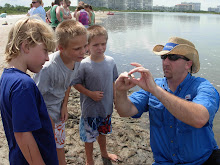Stone crabs are one of Florida’s most valuable fisheries, and like other species we depend on for seafood, they often utilize a variety of habitats and undergo a series of physical transformations throughout their life.
Mating in stone crabs takes place near and offshore during the fall and can only occur when the female has molted and her shell is soft. While eggs are fertilized internally, they are eventually deposited beneath the female’s abdomen or “apron” in an external mass called a sponge. Spawning typically occurs during summer months and females can release millions of fertilized eggs in several intervals.
The eggs, which float in the water column, usually hatch within two weeks and then larval development takes approximately a month to complete. Larvae are planktonic and are transported to coastal and estuarine waters. The first larval stage to emerge from the egg is a called a zoea. As the zoea larvae grows they pass through five distinct changes before developing into a post-larval form called a megalopae. The megalopae, which is more crab-like in appearance, will settle to the bottom where it will take shelter. Here, it will molt several times before transitioning to a juvenile stone crab.
 |
| A juvenile stone crab in my hand |
Unlike adult Florida stone crabs, which are tan in color, juvenile stone crabs up to about 2.5 cm (1 inch) in width are deep purple to black with white flecks on their carapace. Like the adults though, they have distinctive white bands on their legs. As they grow and molt, they will begin to take on the appearance of adult stone crabs. Juveniles can be found living among shell rubble, oyster beds, sponges, and tunicates in estuarine and nearshore habitats.
 |
| An adult stone crab hiding under a ledge |
Florida stone crabs becomes sexually mature by two years of age. Adults will move around and can be found living in burrows among seagrass communities, or offshore out to depths of 200 feet, where they live under ledges or in burrows and crevices associated with hardbottom communities. Age estimates suggest male Florida stone crabs live for seven or eight years while females can live up to eight or nine years.




















